Abstract
With the advantages of large working space, low cost and more flexibility, industrial robots have become an important carrier in intelligent manufacturing. Due to the low rigidity of robotic milling systems, cutting vibrations are inevitable and have a significant impact on surface quality and machining accuracy. To improve the machining performance of the robot, a posture optimization approach based on the dynamic response index is proposed, which combines posture-dependent dynamic characteristics with surface quality for robotic milling. First, modal tests are conducted at sampled points to estimate the posture-dependent dynamic parameters of the robotic milling system. The modal parameters at the unsampled points are further predicted using the inverse distance weighted method. By combining posture-independent modal parameters with calibrating the cutting forces, a dynamic model of a robotic milling system is established and solved with a semi-discretization method. A dynamic response index is then introduced, calculated based on the extraction of the vibration signal peaks. The optimization model is validated through milling experiments, demonstrating that optimizing redundant angles significantly enhances milling stability and quality.
1. Introduction
With the advantages of good flexibility, large working ranges, and low cost, industrial robots have a wide range of applications, such as welding, palletizing, grinding, drilling, and milling [1]. In contrast to traditional computerized numerical control (CNC) milling machines, industrial robots have a low static stiffness, which will result in lower positioning accuracy, while their lack of dynamic stiffness will result in vibrations, making them more susceptible to chatter during robotic machining [2]. Consequently, the insufficient stiffness of industrial robots is a major contributor to poor machining accuracy and negatively impacts surface quality. The limitations in stiffness and positioning accuracy restrict their application in milling operations [3]. Previous research has mainly focused on redundant angle optimization and positioning error prediction separately to resolve the low rigidity issue and improve machining performance, including the stiffness model and performance indexes [4,5], dynamic analysis and posture planning [6,7,8], chatter identification and suppression [9,10]. This article aims to address these issues by developing a dynamic response index model for optimizing redundant degrees of freedom in robotic milling. It combines the influence of both tool vibrations and robot postures on the quality of machined surfaces.
Redundant degrees of freedom are considered crucial for improving precision and quality in robotic milling, accounting for the configuration-dependent dynamic behavior of the robot. Various optimization methods based on kinematic models have been proposed, including joint limits [11], singularity avoidances [12], collision avoidance [13], and trajectory smoothness [14]. Zhang [15] proposed an evaluation index based on recurrent neural networks to realize robot posture control, considering joint angle constraints, velocity constraints and periodic input interference constraints. Mitsi [16] proposed an objective function to optimize the base coordinate position and end-effector posture of the robot. This function is defined as the sum of the squared distances between the preset and actual elements in the end-effector posture matrix. Zeng et al. [17] analyzed the error similarity in the absolute positioning error of the robot and quantified it through the semi-variance function. Xiong et al. [18] adopted a closed-loop error compensation method for robotic flank milling on complex-shaped surfaces. The process involves in situ measurement of the finished surface using a laser tracker, mapping the points to a reference coordinate system, and fitting a deterministic bicubic B-spline surface to extract systematic machining errors. To address the impact of irregular robot posture changes on machining efficiency, Xie et al. [19] proposed a speed adjustment strategy to maximize the feed rate. This strategy operates under the constraints of robot joint velocity, effectively mitigating the influence of uneven robot posture changes and enhancing overall machining efficiency.
To address the inherent weakness of robot stiffness, scholars have introduced a stiffness performance index to improve both the quality of machined surfaces and the stability in robotic machining. For instance, Lin et al. [20] combined the stiffness ellipsoid and external forces to propose an end deformation index of the robot. This index was then utilized to generate a motion performance mapping graph that relates joint angles and external forces, enabling the optimization of the robot posture and workpiece placement through an analysis of six joint-mapping graphs. Addressing the static positioning and tracking errors of the Delta robot, Kelaiaia [21] presented a quasi-static deformation compensation model. Considering stiffness as a constraint condition and the smoothness of the robot posture as the optimization objective function, Ding et al. [22] employed the shortest path algorithm to calculate a sequence of posture variations with maximum smoothness along the feeding trajectory. However, under high stiffness requirements, obtaining machining trajectories with fine smoothness became challenging due to limitations in the range of available postures. Chen et al. [23] focused on optimizing robot posture by improving stiffness performance in the direction of the cutting force during planar milling. Dumas et al. [24] optimized the redundant degrees of freedom by minimizing the deformation in the orientation required for machining accuracy in order to reduce machining errors. Considering the limitation of robot kinematics and the conventional toolpath pattern, Liao et al. [25] proposed a region-based toolpath generation method to improve robot stiffness for robotic milling of freeform surfaces. For the evaluation of robot posture stiffness, Chen et al. [26] introduced a comprehensive deformation index, considering both spindle weight-induced and cutting force-induced deformations. Lee et al. [27] proposed a deformation energy model for a stiffness evaluation, emphasizing that simultaneous optimization of robot posture and workpiece position could significantly improve machining quality. However, these stiffness performance indexes mainly considered static stiffness properties.
Several recent studies have proposed dynamic performance indexes to improve the dynamic characteristics of robotic milling systems. In their experimental research, Celikag et al. [28] investigated the chatter stability in robotic milling with respect to robot posture, revealing a significant impact on chatter suppression. Mohanmmed et al. [29] proposed an energy optimal index for robot assembly path planning, considering the dynamic characteristics of robots. Mousavi et al. [30] optimized robot machining postures based on the cutting depth limit index, aiming to enhance the stability of robotic milling. Xiong et al. [31] used the eigenvalues of the frequency response matrix as a dynamic index, demonstrating its effectiveness by comparing the index values at different frequencies. Cvitanic et al. [32] employed the maximum transient vibration amplitude during the machining process as a dynamic performance index. The optimized path reduced the vibration amplitude, demonstrating the superiority of the dynamic performance index over the static stiffness index. Wang et al. [33] developed an optimization model of redundant degrees of freedom in robotic milling, considering chatter stability and the constraints of robot motion performance. Hou et al. [34] proposed a posture optimization method based on the surface location error, which improved machining accuracy and surface quality by optimizing the functional redundant degrees of freedom in robotic milling. Through control of the robot redundant angle, the dynamic performance of the robot is enhanced, which improves the machining stability and surface quality. These performance optimization indicators do not effectively address machining accuracy, leading to difficulties in achieving acceptable dimensional tolerances and surface quality in the produced parts.
Many studies on robotic milling processes simplify the analysis, neglecting the impact of dynamic characteristics on machining accuracy. On the other hand, the few studies concentrating on dynamic features tend to emphasize vibration amplitudes and chatter stability, neglecting machining accuracy in the process. Consequently, challenges persist in achieving parts with acceptable dimensional tolerances and surface quality. To address this, our article proposes a posture optimization model utilizing a dynamic response index. This model integrates posture-dependent robot dynamic performance with machining errors. By calibrating and conducting modal tests in the robot workspace, we first investigate the dynamic behavior of the robotic milling system. The dynamic response index is then proposed to evaluate the quality of surface machining based on the extraction of the vibration signal peaks. Through this approach, we provide a more comprehensive understanding of the machining process, emphasizing dynamic response indexes for improved surface machining quality.
The remainder of this article is organized as follows. In Section 2, the machining dynamics of the robot milling system are described and the stability limit is derived. And a posture optimization scheme based on the dynamic response index is proposed. In Section 3, the necessity and effectiveness of this index are verified through a series of experiments. Section 4 summarizes this article.
2. Redundant Degrees of Freedom Optimization in Robotic Milling
2.1. Problem Description of Redundant Degrees of Freedom in Robotic Milling
Typically, the posture of the robot end effector, such as milling tools, is derived from the cutter location data denoted as CL (x, y, z, I, J, K), which are generated by a five-axis CAD/CAM software system. Here, (x, y, z) denotes the tool center point, and (I, J, K) represents the unit vector indicating the tool axis direction. Essentially, the CL file provides the tool’s position and orientation parameters in the workpiece coordinate system {W}. Conversely, the tool coordinate system {T} is established in relation to the workpiece coordinate system {W} through a six-dimensional tuple (x, y, z, α, β, γ), where (α, β, γ) represents the X–Y–Z Euler angles. Consequently, when executing a G code robot program for milling, the cutter location data CL (x, y, z, I, J, K) and tool posture (x, y, z, α, β, γ), should satisfy the following conditions:
where is the homogeneous transformation matrix of the tool coordinate system relative to the workpiece coordinate system.
The following equation can be derived from Equation (1):
According to Equation (2), given cutter location data CL (x, y, z, I, J, K), only the initial five components of the six-dimensional tuple (x, y, z, α, β, γ) can be determined. This implies that the Euler angle γ remains arbitrary, introducing redundancy. As shown in Figure 1, when a six-axis industrial robot engages in a five-axis milling task, it introduces a redundant degree of freedom represented by the arbitrary Euler angle γ. This redundancy arises because the task only requires determination of five components, leaving one degree of freedom unspecified. To solve the inverse kinematics problem for the robot, setting the Euler angle γ becomes essential. Addressing this challenge involves optimizing the robot’s redundant degree of freedom to achieve an improved posture, consequently enhancing machining accuracy.
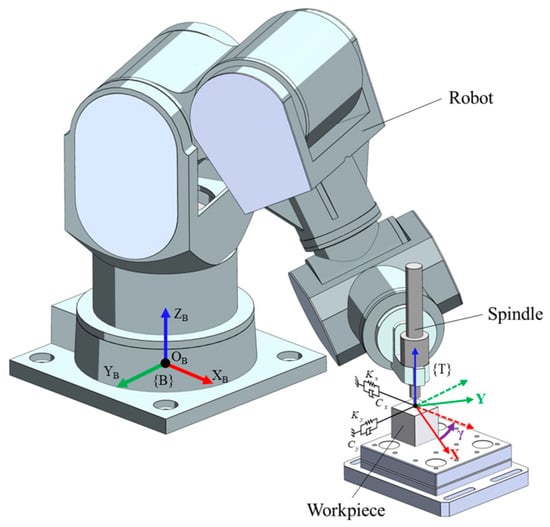
Figure 1.
Schematic diagram of the redundant angle γ.
2.2. Redundant Degree of Freedom Optimization Model Considering Tool Vibration
When employing a six-axis industrial robot for a five-axis task, the introduction of a redundant degree of freedom γ occurs, resulting in an infinite number of potential cutting postures for each cutter location point P. In robotic milling, the inherent low rigidity of the robotic milling system increases its susceptibility to chatter phenomena, posing a potential detriment to surface quality. Selecting an appropriate posture becomes crucial to maintaining a steady-state operation and achieving the best surface finish.
Beyond addressing chatter stability, other constraints must be considered, including avoiding joint angles nearing limit positions, maintaining non-singular postures, and preventing collisions. These constraints are essential for ensuring the safety and optimal functioning of the robotic system, considering practical physical limitations. Additionally, to enhance workpiece surface quality, this article introduces a dynamic response index for determining the optimal redundant degree of freedom γ. Taking into consideration the mentioned constraints, the optimization model is formulated as follows:
where represents the l-th element in the peak vector of the vibration signal, and is the total number of elements in the peak vector. signifies the vibration displacement in the specified direction, with superscript p denoting the point P and subscript l indicating the l-th element. In the milling experiment, the redundant angle γ is within the range of [−45°, 45°]. The inverse kinematics transformation of the robot is denoted as , and the joint angle is represented by (q = 1, 2, …, 6), with the subscript q representing the number of joint angles. denotes the state transfer matrix, and the term refers to the eigenvalues of the matrix , with specific details provided in Section 2.3.3. Additionally, as part of the effort to enhance the robot performance and surface quality, this article introduces a dynamic response index (DRI) for identifying the optimal redundant degree of freedom γ. For more detailed information on the dynamic response index, please refer to Section 2.3.4.
2.3. Solution of Redundant Degree of Freedom Optimization Model
2.3.1. Evaluation of Posture-Dependent Frequency Response Function
Typically, the frequency response function can be directly obtained through experimental modal testing methods [35,36]. However, when dealing with industrial robots, the dynamic characteristics can vary significantly across different postures. Conducting modal tests on all the postures within the entire workspace becomes challenging and time-consuming. Hence, it is necessary to develop an appropriate model to predict the frequency response function of the robot milling processing system at an arbitrary posture.
In this article, the inverse distance weighted method [37] is utilized to obtain the frequency response function of the robot tool tip at specific postures. This method combines the weight values, determined by the Euclidean distance of joint angles across different postures, with their corresponding frequency response values. Essentially, the frequency response data obtained from the modal experiments for various postures are employed to predict the frequency response value for an arbitrary posture within the Cartesian workspace. Based on the modal tests at postures within the workspace, the frequency response function at the e-th posture is determined by the following equation:
where is the frequency response function at the e-th posture for prediction, represents the frequency response function at the s-th test posture, and corresponds to the number of the weighted frequency response function. represents the weight coefficients and is defined as follows:
with
where denotes the Euclidean distance in the joint space, which is utilized to estimate the joint angular distance between the predicted posture and the test posture .
Based on the predicted frequency response function at the e-th posture, the relationship between the frequency response function matrix and the modal parameters can be expressed as follows:
where is the frequency, is the number of modes, i is the imaginary unit, are the residues at nodes g and h of mode r, is the pole of mode r, and * denotes complex conjugation.
The poles can be expressed as
where and are the damping ratio and eigenfrequency of mode r, respectively.
The residues are composed of a modal scaling constant , and the mode shape coefficients in the nodes g and h, as follows:
where is the modal mass of mode r. are the mode shape coefficients in nodes g and h for mode r, respectively.
In this article, the modal mass is calculated by scaling the mode shapes to unity modal A. The modalfit function in MATLAB is employed to obtain the modal mass, modal damping, and modal stiffness.
2.3.2. Dynamic Model of a Robotic Milling System
Due to the higher stiffness of the tool in the axial direction compared to the other orthogonal directions [38,39], axial vibration is neglected. As shown in Figure 2, the dynamic model of the robot milling system is simplified to a two-degree-of-freedom (2-DoF) vibration system in the x and y directions. For a given configuration θ in joint space, the dynamic model of the robot can be expressed as:
where M(θ), C(θ) and K(θ) are the posture-dependent modal mass, damping, and stiffness matrix, with

Figure 2.
Robotic milling dynamic model.
Here, are the modal mass, damping and stiffness matrices of the system along the x and y direction, respectively; is the displacement vector; and represents the cutting force and is calculated based on the cutting theory [40] as follows
where is the axial cutting depth; and is the specific directional coefficients matrix, which can be calculated by the following equation:
with
where is a unit step function used to judge whether each cutter tooth participates in the milling process; and represent the tangential force coefficient and radial force coefficient, respectively; and is the angular position of j-th tooth. The time delay T satisfies , N is the number of teeth and Ω is the spindle speed (r/min). The stationary cutting force vector can be expressed as
where denotes the feed per tooth.
2.3.3. Regenerative Chatter Analysis of a Robotic Milling System
In the analysis of regenerative chatter in robotic milling systems, the static force term is considered to have negligible effects on stability [41]. Consequently, Equation (10) can be revised as follows
In order to predict the posture-dependent stability of the robotic milling process, the semi-discretization method [42] is used to solve the delay differential equations. Using the Cauchy transformation and linear approximation of the delayed term, Equation (16) can be expressed as
with
where .
Using the semi-discretization method, the time period T is discretized into time intervals such as in which k is an integer. The period coefficient matrix can be approximately replaced by the average constant in each time interval , as follows:
Consequently, the first-order equations of motion for the milling system can be expressed as follows:
In this case, the delayed term is approximated with as follows:
The weighting coefficients are expressed as follows:
In the milling system, the delayed term can be approximated as a weighted linear combination of the delayed discrete values taken at time and . For the initial condition , Equation (22) is solved as follows:
With substituted in Equation (25) and applying Equation (23), can be defined as follows:
with
in which represents the identity matrix.
Based on Equation (26), a discrete map between instants and can be defined as
where , and
According to Floquet theory, if represents the initial state of the system, then the state after one period is expressed as:
where .
Based on Floquet theory, the system is stable if all the eigenvalues of are less than one, the system is stable. Otherwise, the milling process is unstable.
2.3.4. Dynamic Response Index in Robotic Milling
Under ideal conditions, if there is no chatter and the motion is described by , the corresponding Equation (10) can be represented as
By combining the cutting forces and the predicted frequency response function, the tool displacement can be calculated, as in .
In robotic milling, the actual paths of the teeth are affected by the vibrations of the tool. If the cutting process is stable, the actual path of the j-th tooth will be determined by [43].
where R is the radius of the tool, N is the number of tool teeth, and is the spindle speed, and is the feeding velocity.
According to Equation (32), the dynamic response index can be determined by extracting the vibration signal peaks to evaluate the machined surface quality, as follows:
where is the peak vector of the vibration signal, and is the total number of elements in the peak vector.
2.4. Flowchart for Solving the Redundant Degree of Freedom Optimization Model
As illustrated in Figure 3, the functional redundant angle optimization model established in this article is based on a dynamic response index. This model is a multi-objective optimization framework that takes into account both kinematics and dynamics. The optimization process includes several steps:
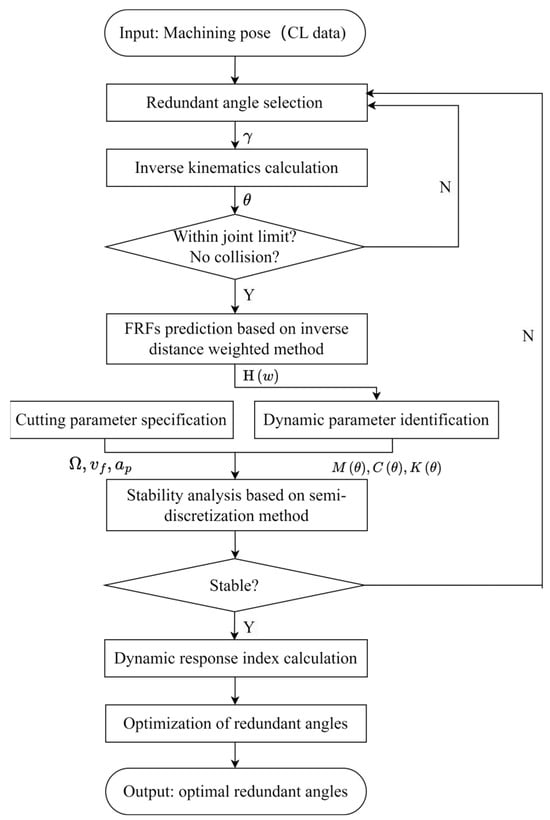
Figure 3.
Optimization flowchart for the redundant degrees of freedom.
Step 1. Discretization of the redundancy angle: The redundant angle is discretized, resulting in a set of robot joint angles (θ) that adhere to the joint limit constraints. These joint angles are obtained through inverse kinematic calculations.
Step 2. Posture-dependent frequency response function prediction: Using the modal tests and the inverse distance weighted method, the frequency response function for specific postures is predicted. The modal parameters are then identified with the modalfit function in MATLAB, scaling the mode shapes to unity modal A.
Step 3. Stability analysis: With the posture-independent modal parameters, the stability of robotic milling system is assessed using the semi-discretization method.
Step 4. Dynamic response index calculation: The evaluation index of the minimum amplitude is employed to calculate the dynamic response index for specified postures.
Step 5. Optimization of redundant angles: The robot posture is optimized by minimizing the DRI.
The model aims to enhance the efficiency and stability of a robotic milling system by optimizing the redundant angle. The process involves discrete angle determination, prediction of frequency response functions, stability analysis, and dynamic response index calculation to identify the optimal redundant angles for stable robotic milling operations.
3. Milling Experimental Validation
In this section, a set of experiments are conducted. Section 3.1 provides the experimental parameters for Section 3.2 and Section 3.3. The modal parameters identification based on the inverse distance weighted method is detailed in Section 3.2. Section 3.3 illustrates the influence of the redundant angle on milling stability. The effectiveness of the optimization model is demonstrated in Section 3.4.
3.1. Experimental Setup
As shown in Figure 4, the robotic milling system is composed of a self-designed robot, a spindle, and a cutting tool. The robot is structured with Y-series harmonic reducers, offering six degrees of freedom (6-DoF). The robot exhibits a positioning accuracy of 0.12 mm and a positioning repeatability of 0.018 mm. The spindle operates at a maximum rotational speed of 40,000 r/min. Figure 4 illustrates the selection of points for the milling experiment, and the coordinates of each reference point are detailed in Table 1. During the milling process, the robot performs the milling operation at different redundancy angles at each point in the y-axis direction. The machining parameters are listed in Table 2.
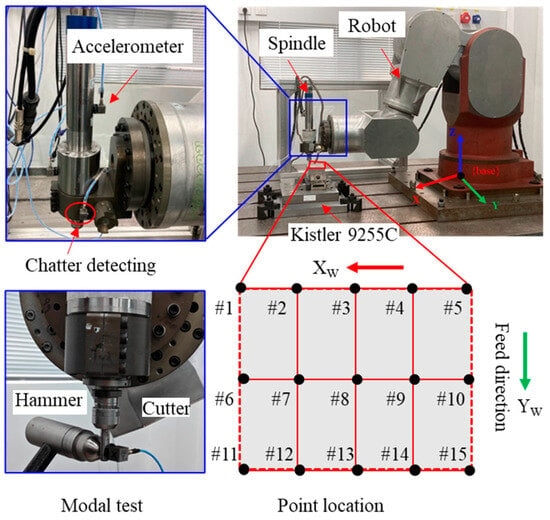
Figure 4.
Experimental setup.

Table 1.
Point positions in the base coordinate system (unit: mm).

Table 2.
Cutting parameters in the milling experiment.
In this section, a carbide flat-end milling cutter with integral carbide is used, and wear is neglected. The cutter has a diameter of 6 mm, 3 teeth, a helix angle of 45°, and a clamped tool overhang of 25 mm. The workpiece is made of aluminum alloy 7075-T6, with dimensions of 100 mm × 80 mm × 60 mm. The cutting force coefficients obtained after calibration are N/mm2, N/mm2.
The robot is tested through 15 sets of impact modal tests, each performed under 15 different postures within the machining plane to capture the frequency response distribution characteristics. Figure 4 illustrates the position distribution and numbering. The impact tests utilize the WX-HM03 hammer with a sensitivity of 0.0814 mV/N, along with a three-axis accelerometer (PCB LW22652), featuring a sensitivity of 10.16 mV/m/s2. These instruments are integrated into the DHDAS dynamic signal acquisition system, with an IEPE input mode for both the hammer and accelerometer. The test results are obtained using a multi-point response single-point force measurement method. Additionally, for monitoring the milling process, a three-axis accelerometer (PCB LW29042) with a sensitivity of 10.23 mV/m/s2 is attached to the spindle.
3.2. Modal Parameter Identification
During robot milling, the dominant mode of the robot tool tip, which contributes the most vibration, is considered dominant in this article. The influence of other modes is neglected. Using the frequency response data from the experiment, the inverse distance weighted method is employed to predict the frequency response for point #1. Figure 5 shows the frequency response function in the x direction at γ = −40°. The least-squares complex exponential method is used to fit the dominant modes within a specific frequency range in the milling process. As illustrated in Figure 5, a single dominant mode is observed in this frequency range. It is apparent from the figure that the fitted curve is consistent with the original curve, achieving a good approximation.
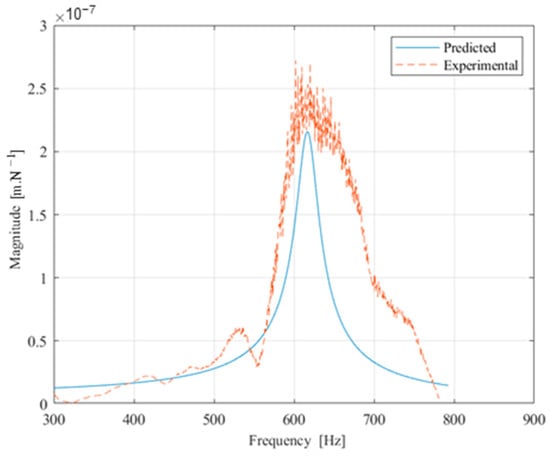
Figure 5.
Frequency response curve for point #1 with γ = −40°.
The identification of modal parameters is the most commonly utilized method for analyzing frequency response functions, providing crucial insights for future analysis of chatter stability. Through examination of the fitted frequency response function, key modal parameters such as the natural frequency, damping ratio, and others for the robot processing system can be determined using the modalfit function. The modal mass is calculated by scaling the mode shapes to unity modal A.
As illustrated in Figure 6, the distribution of the modal stiffness at different redundant angles is presented for point #1. The results indicate that at redundancy angles of 0°, 10°, and 20°, the modal stiffness is relatively small. Conversely, at redundancy angles of −40°, −30°, and −20°, the modal stiffness shows minimal variation. A redundancy angle of 40° represents the maximum stiffness. The modal stiffness undergoes significant changes as the redundancy angle increases, while it undergoes relatively little change as the redundancy angle decreases.
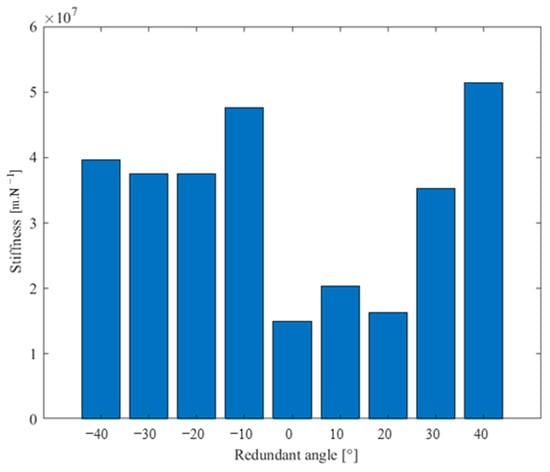
Figure 6.
Modal stiffness at different redundant angles for point #1.
3.3. Analysis of Milling Stability with Redundant Angles
To assess the chatter stability at different redundancy angles, we selected reference points #2, #6, #10, and #14 along feed directions, as shown in Figure 4. The corresponding coordinates and cutting parameters are detailed in Table 2. The joint angles corresponding to these points can be found in Table A1.
Due to practical physical constraints, the redundant angle γ is in the range of [−45°, 45°]. In this section, the redundant angle γ is set to the specific values of −30°, 0°, and 30° for comparison. The modal tests indicate minimal changes in modal parameters on the upper surface due to the small size of the workpiece. Consequently, the robot maintains a fixed posture while milling each slot.
Figure 7 illustrates the distinct effects of different redundant angles on the milling stability at the same reference point. This suggests that the choice of the redundant angle can influence the stability of the milling process. The results indicate considerable variation in the cutting depth limit across different reference points, highlighting the substantial impact of robot posture on machining stability. Therefore, avoiding chatter is crucial to ensure an optimal posture.
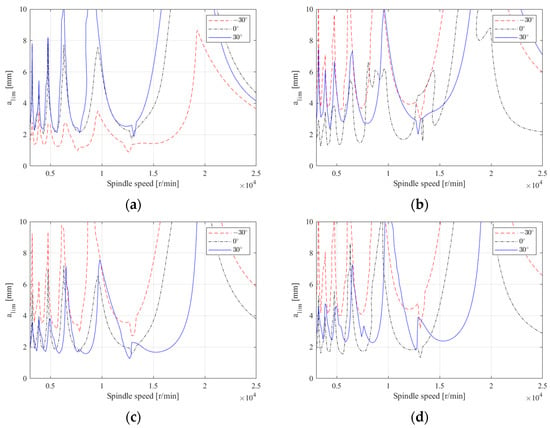
Figure 7.
Stability lobes of different redundant angles for different points: (a) Point #2, (b) Point #6, (c) Point #10, and (d) Point #14.
Furthermore, an accelerometer is utilized to measure the vibration signal, and Fourier transform is applied to obtain the frequency spectrogram, allowing the identification of chatter occurrence during the machining process. The examination of the spectrogram focuses on the increase in amplitude associated with the main mode (flutter frequency). Figure 8 illustrates the acceleration spectrum diagram at different redundancy angles.
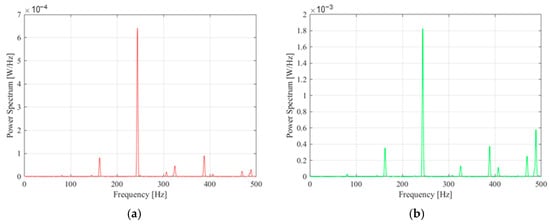
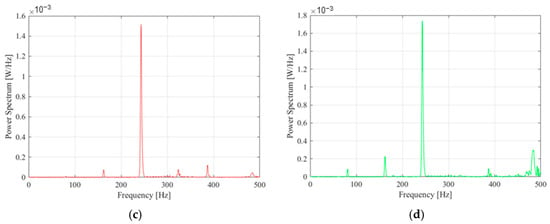
Figure 8.
Acceleration power spectrogram with different redundant angles at point #2: (a) γ = 0° along x-axis direction, (b) γ = 0° along y-axis direction, (c) γ = 20° along x-axis direction, and (d) γ = 20° along y-axis direction.
Given the use of a three-tooth cutting tool in the experiment, the milling force frequency was approximately 250 Hz when the spindle speed was 5000 r/min. The results indicate that at a milling depth of 1.0 mm, the dominant frequency in the x, y, and z directions is roughly 250 Hz. The experiment did not exhibit any jitter or harsh sounds, and the spectrum diagram indicates that no other frequency with rising amplitude appeared except for the larger amplitude at the conversion frequency. Thus, the experimental observations of chatter align with the theoretical calculations, confirming stability in the machining process at this posture. These findings highlight the impact of the redundant angle of the milling robot on machining stability.
3.4. Posture Optimization Based on the Dynamic Response Index
To enhance the quality of surface machining, the optimal redundant angle using the proposed modal for a slot along the y-axis direction is approximately 20°, as shown in Figure 9. The chatter stability and dynamic characteristics of the robotic milling system are influenced not only by the redundant angle but also by the specific position. In this section, the feeding distance for each slot is kept short enough to approximate it as a consistent machining condition for verification.
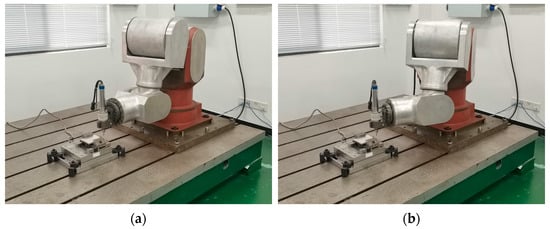
Figure 9.
Milling experiments: (a) initial posture with γ = 0°, and (b) optimized posture with γ = 20°.
Instead of altering the tool position during the milling process, the aluminum workpiece is moved after each feeding to ensure that the robot follows the same path. For slot milling, various redundancy angles, such as −40°, −30°, −20°, −10°, 0°, 10°, 20°, 30°, and 40°, are employed. The experiments are carried out with the same cutting parameters as shown in Table 1. When the posture of the robot changes during milling, the robot controller records the parameters of each joint angle for real-time monitoring, and the cutting force is measured using a Kistler 9255C dynamometer (see in Figure 10).

Figure 10.
(a) Sampled trajectory of each robot joint with γ = 0°, and (b) cutting force with γ = 0° (sampling frequency: 10 kHz).
The machined surface of the workpiece, as depicted in Figure 11, reveals significant insights. Figure 12 illustrates the measurement of the surface roughness of the workpiece using the Alicona optical 3D measuring instrument. A comparison of the measured values and the predicted results using the dynamic response index is presented in Figure 13 and summarized in Table 3.
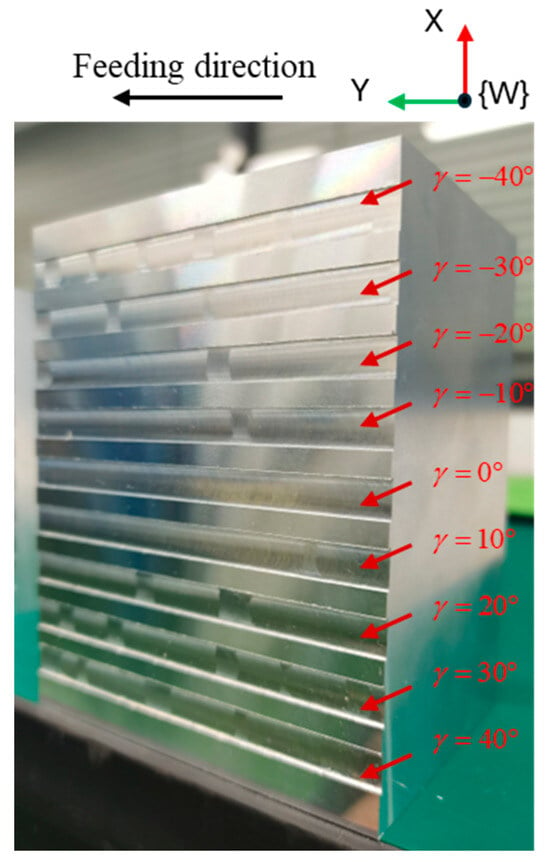
Figure 11.
Machined surface at different redundant angles.
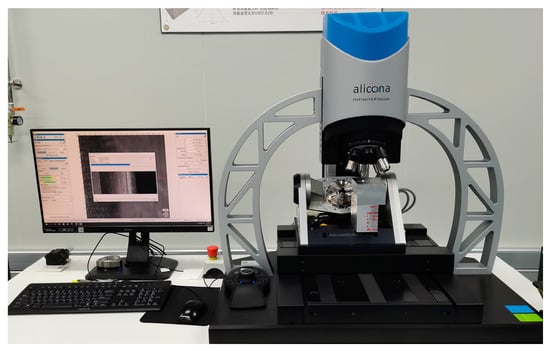
Figure 12.
Optical surface roughness measurement instrument.
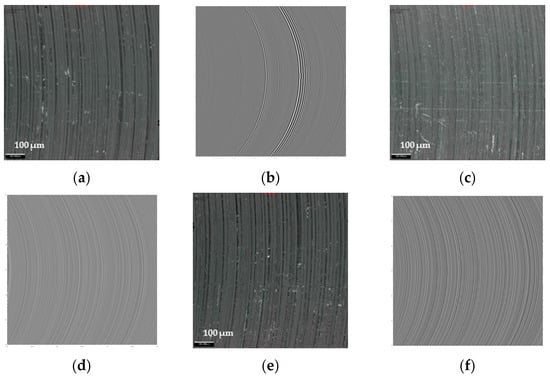
Figure 13.
Measured and predicted surface roughness of the robot slot milling at different redundant angles: (a) measured at γ = −40°, (b) predicted at γ = −40°, (c) measured at γ = 0°, (d) predicted at γ = 0°, (e) measured at γ = 30°, and (f) predicted at γ = 30°.

Table 3.
Surface roughness of robotic milling with different redundancy angles.
According to Figure 13 and Table 3, the results suggest a noticeable impact of the redundant angle variations on the surface roughness. Despite fluctuations, the surface roughness remains within the specified range, confirming the ability of the robotic milling system to achieve the desired machining accuracy. Particularly, machining surfaces with redundant angles between −20° and 0° exhibit finer surface roughness. Conversely, a redundant angle of γ = 10° results in a relatively larger prediction error.
As shown in Figure 14, both the predicted value and measured value follow similar trends with changes in the redundant angles. Since the vibration magnitude and machining error are approximated by a linear relationship, the predicted results are slightly larger than the actual measurement. According to the experimental results, the dynamic response index can be considered an effective estimate of surface roughness. Optimized redundant angles have the potential to improve robotic milling accuracy, as indicated by the experimental results.
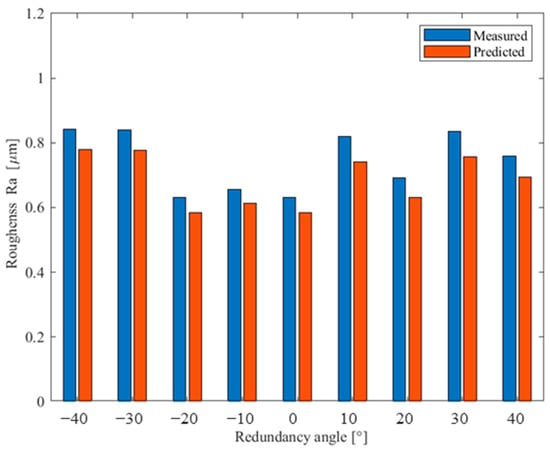
Figure 14.
Surface roughness with different redundant angles.
4. Conclusions
In contrast to CNC machines, industrial robots have inherent challenges in stiffness and positioning accuracy, leading to difficulties in achieving desired dimensional tolerances and surface quality during robotic milling. Previous research has predominantly focused on addressing these challenges by separately optimizing the redundant angles and predicting positioning errors. To address these issues, this article focuses on developing a dynamic response index model to optimize the redundant degrees of freedom, taking into consideration the impact of both tool vibrations and robot postures on the quality of machined surfaces.
The proposed model incorporates the posture-dependent dynamic characteristics of the robotic milling system. By utilizing the posture-independent modal parameters and calibrated cutting forces, a dynamic model for robotic milling is established and solved through the semi-discretization method. Through the extraction of the vibration signal peaks, the dynamic response index is established to estimate the surface machining quality.
The combination of simulation and experimental studies confirming the effectiveness of the proposed optimization method indicates a promising solution for optimizing stability and machining quality, with potential benefits for various practical applications.
Author Contributions
J.L.: conceptualization, methodology, investigation, writing—original draft preparation. Y.Z. (Yiyang Zhao): validation, visualization, writing—review and editing. Y.N.: validation, visualization, writing—review and editing. J.C.: validation, visualization, writing—review and editing. L.Z.: supervision, conceptualization, resources, writing—review and editing. Y.Z. (Yanzheng Zhao): supervision, conceptualization, resources, writing—review and editing. All authors have read and agreed to the published version of the manuscript.
Funding
This research was funded by the China Postdoctoral Science Foundation, Grant No. 2023M742265, and the National Key Research and Development Program of China for Robotics Serialized Harmonic Reducer Fatigue Performance Analysis and Prediction and Life Enhancement Technology Research, Grant No. 2017YFB1300603.
Data Availability Statement
All the data generated or analyzed during this study are included in this paper or are available from the corresponding authors on reasonable request. Some data are not publicly available due to intellectual property protection.
Conflicts of Interest
The authors declare no conflicts of interest.
Nomenclatures
| The unit vector representing the direction of the tool axis | |
| X–Y–Z Euler angle | |
| Homogeneous transformation matrix of the tool coordinate system relative to the workpiece coordinate system | |
| The l-th element in the peak vector of the vibration signal | |
| The total number of elements in the peak vector | |
| The vibration displacement in the specified direction, with superscript p denoting the point P, and subscript l indicating the l-th element | |
| Inverse kinematics | |
| Joint angle | |
| The state transfer matrix | |
| The number of the tested postures | |
| , | The frequency response function of posture ,, respectively |
| The Euclidean distance in joint space | |
| The predicted frequency response function at the nodes g and h. | |
| Frequency in rad/s | |
| The number of modes | |
| i | The imaginary unit |
| The residues at nodes g and h of mode r | |
| A modal scaling constant | |
| ,, | The pole, damping ratio, natural frequency of mode r |
| The mode shape coefficients in nodes g and h for mode r | |
| M(θ), C(θ) and K(θ) | The posture-dependent modal mass, damping, and stiffness matrix |
| The modal mass, damping and stiffness matrices of the system along the x and y directions | |
| Cutting force | |
| Cutting depth | |
| The specific directional coefficients matrix | |
| A unit step function | |
| Cutting width | |
| , | The tangential force coefficient and radial force coefficient |
| The angular position of j-th tooth | |
| Number of teeth | |
| Spindle speed in r/min | |
| Cutting force vector | |
| Feed per tooth | |
| Time periodic matrix | |
| Delay time | |
| The identity matrix | |
| The initial state matrix | |
| Feeding velocity |
Appendix A

Table A1.
Joint angle set of different TCP positions and redundant angles.
Table A1.
Joint angle set of different TCP positions and redundant angles.
| Posture | Joint Angle (°) | Posture | Joint Angle (°) | ||
|---|---|---|---|---|---|
| −40° | #2 | 25.22, 9.89, 29.42, 70.34, 74.60, −36.63 | 10° | #2 | −10.15, 24.05, −1.38, −21.69, 68.79, 8.19 |
| #6 | 23.76, 4.62, 39.66, 70.57, 72.02, −41.18 | #6 | −9.38, 21.09, 5.71, −21.51, 64.83, 9.52 | ||
| #10 | 29.70, −2.21, 52.36, 76.67, 74.55, −48.34 | #10 | −0.65, 21.65, 4.40, −11.82, 64.43, 5.16 | ||
| #14 | 27.52, −4.10, 55.79, 75.61, 72.54, −49.47 | #14 | −2.75, 19.96, 8.29, −14.40, 62.51, 6.76 | ||
| −30° | #2 | 21.42, 17.16, 14.45, 55.81, 70.92, −25.69 | 20° | #2 | −17.71, 21.29, 5.24, −40.83, 69.30, 16.98 |
| #6 | 20.04, 13.23, 22.69, 55.84, 67.86, −29.05 | #6 | −16.47, 17.97, 12.68, −40.67, 65.78.19.41 | ||
| #10 | 26.78, 9.31, 30.57, 63.32, 69.44, −34.96 | #10 | −8.38, 19.53, 9.24, −31.64, 64.94, 14.63 | ||
| #14 | 24.41, 8.03, 33.09, 61.67, 67.50, −35.37 | #14 | −10.08, 17.43, 13.85, −34.13, 63.29, 16.94 | ||
| −20° | #2 | 15.60, 21.75, 4.18, 38.53, 69.18, −15.80 | 30° | #2 | −23.26, 16.41, 16.05, −57.80, 71.27, 27.02 |
| #6 | 14.50, 18.47, 11.61, 38.45, 65.61, −18.16 | #6 | −21.79, 12.41, 24.38, −57.77, 68.26, 30.43 | ||
| #10 | 26.78, 9.31, 30.57, 63.32, 69.44, −34.96 | #10 | −14.56, 15.19, 18.64, −49.85, 66.63, 25.19 | ||
| #14 | 19.63, 14.83, 19.38, 45.04, 64.34, −23.44 | #14 | −15.90, 12.46, 24.27, −52.16, 65.41, 28.19 | ||
| −10° | #2 | 7.82, 24.26, −1.91, 19.17, 68.78, −7.17 | 40° | #2 | −26.83, 8.72, 31.73, −71.96, 75.21, 38.09 |
| #6 | 7.23, 21.33, 5.17, 19.11, 64.78, −8.40 | #6 | −25.31, 3.23, 42.30, −72.14, 72.66, 42.78 | ||
| #10 | 15.68, 20.01, 8.18, 28.62, 64.80, −13.08 | #10 | −18.92, 7.92, 33.30, −65.61, 70.11, 36.88 | ||
| #14 | 13.13, 18.74, 11.01, 26.20, 62.85, −12.65 | #14 | −19.98, 4.01, 40.81, −67.71, 69.35, 40.71 | ||
| 0° | #2 | −1.21, 25.00, −3.78, −1.30, 68.79, 0.47 | |||
| #6 | −1.12, 22.17, 3.20, −1.24, 64.64, 0.53 | ||||
| #10 | 7.77, 21.80, 4.05, 8.62, 64.40, −3.75 | ||||
| #14 | 5.36, 20.38, 7.34, 6.05, 62.41, −2.81 | ||||
References
- Wang, W.; Guo, Q.; Yang, Z.; Jiang, Y.; Xu, J. A State-of-the-Art Review on Robotic Milling of Complex Parts with High Efficiency and Precision. Robot. Comput.-Integr. Manuf. 2023, 79, 102436. [Google Scholar] [CrossRef]
- Yuan, H.; Courteille, E.; Deblaise, D. Static and Dynamic Stiffness Analyses of Cable-Driven Parallel Robots with Non-Negligible Cable Mass and Elasticity. Mech. Mach. Theory 2015, 85, 64–81. [Google Scholar] [CrossRef]
- Zhu, Z.; Tang, X.; Chen, C.; Peng, F.; Yan, R.; Zhou, L.; Li, Z.; Wu, J. High Precision and Efficiency Robotic Milling of Complex Parts: Challenges, Approaches and Trends. Chin. J. Aeronaut. 2022, 35, 22–46. [Google Scholar] [CrossRef]
- Bu, Y.; Liao, W.; Tian, W.; Zhang, J.; Zhang, L. Stiffness Analysis and Optimization in Robotic Drilling Application. Precis. Eng. 2017, 49, 388–400. [Google Scholar] [CrossRef]
- Li, G.; Zhu, W.; Dong, H.; Ke, Y. Stiffness-Oriented Performance Indices Defined on Two-Dimensional Manifold for 6-DOF Industrial Robot. Robot. Comput.-Integr. Manuf. 2021, 68, 102076. [Google Scholar] [CrossRef]
- Slavkovic, N.R.; Milutinovic, D.S.; Glavonjic, M.M. A Method for Off-Line Compensation of Cutting Force-Induced Errors in Robotic Machining by Tool Path Modification. Int. J. Adv. Manuf. Technol. 2014, 70, 2083–2096. [Google Scholar] [CrossRef]
- Liu, C.; Li, Y.; Shen, W. A Real Time Machining Error Compensation Method Based on Dynamic Features for Cutting Force Induced Elastic Deformation in Flank Milling. Mach. Sci. Technol. 2018, 22, 766–786. [Google Scholar] [CrossRef]
- Jin, Y.; Gu, Q.; Liu, S.; Yang, C. Experimental Investigation and Modeling of Force-Induced Surface Errors for the Robot-Assisted Milling Process. Machines 2023, 11, 655. [Google Scholar] [CrossRef]
- Mohammadi, Y.; Ahmadi, K. Chatter in Milling with Robots with Structural Nonlinearity. Mech. Syst. Signal Process. 2021, 167, 108523. [Google Scholar] [CrossRef]
- Gao, K.; Zhou, X.; Wang, R.; Fan, M.; Han, H. Robotic Milling Stability Optimization Based on Robot Functional Redundancy. Ind. Robot Int. J. Robot. Res. Appl. 2023, 50, 1036–1047. [Google Scholar] [CrossRef]
- Huo, L.; Baron, L. The Self-Adaptation of Weights for Joint-Limits and Singularity Avoidances of Functionally Redundant Robotic-Task. Robot. Comput.-Integr. Manuf. 2011, 27, 367–376. [Google Scholar] [CrossRef]
- Xiao, W.; Strauß, H.; Loohß, T.; Hoffmeister, H.-W.; Hesselbach, J. Closed-Form Inverse Kinematics of 6R Milling Robot with Singularity Avoidance. Prod. Eng. Res. Devel. 2011, 5, 103–110. [Google Scholar] [CrossRef]
- Xiao, W.; Huan, J. Redundancy and Optimization of a 6R Robot for Five-Axis Milling Applications: Singularity, Joint Limits and Collision. Prod. Eng. Res. Devel. 2012, 6, 287–296. [Google Scholar] [CrossRef]
- Shi, Z.; Zhang, W.; Ding, Y. A Local Toolpath Smoothing Method for a Five-Axis Hybrid Machining Robot. Sci. China Technol. Sci. 2023, 66, 721–742. [Google Scholar] [CrossRef]
- Zhang, Y.; Li, S.; Kadry, S.; Liao, B. Recurrent Neural Network for Kinematic Control of Redundant Manipulators With Periodic Input Disturbance and Physical Constraints. IEEE Trans. Cybern. 2019, 49, 4194–4205. [Google Scholar] [CrossRef] [PubMed]
- Mitsi, S.; Bouzakis, K.-D.; Sagris, D.; Mansour, G. Determination of Optimum Robot Base Location Considering Discrete End-Effector Positions by Means of Hybrid Genetic Algorithm. Robot. Comput.-Integr. Manuf. 2008, 24, 50–59. [Google Scholar] [CrossRef]
- Zeng, Y.; Tian, W.; Liao, W. Positional Error Similarity Analysis for Error Compensation of Industrial Robots. Robot. Comput.-Integr. Manuf. 2016, 42, 113–120. [Google Scholar] [CrossRef]
- Xiong, G.; Li, Z.; Ding, Y.; Zhu, L. A Closed-Loop Error Compensation Method for Robotic Flank Milling. Robot. Comput.-Integr. Manuf. 2020, 63, 101928. [Google Scholar] [CrossRef]
- Xie, F.; Chen, L.; Li, Z.; Tang, K. Path Smoothing and Feed Rate Planning for Robotic Curved Layer Additive Manufacturing. Robot. Comput.-Integr. Manuf. 2020, 65, 101967. [Google Scholar] [CrossRef]
- Lin, Y.; Zhao, H.; Ding, H. Posture Optimization Methodology of 6R Industrial Robots for Machining Using Performance Evaluation Indexes. Robot. Comput.-Integr. Manuf. 2017, 48, 59–72. [Google Scholar] [CrossRef]
- Kelaiaia, R. Improving the Pose Accuracy of the Delta Robot in Machining Operations. Int. J. Adv. Manuf. Technol. 2017, 91, 2205–2215. [Google Scholar] [CrossRef]
- Peng, J.; Ding, Y.; Zhang, G.; Ding, H. Smoothness-Oriented Path Optimization for Robotic Milling Processes. Sci. China Technol. Sci. 2020, 63, 1751–1763. [Google Scholar] [CrossRef]
- Chen, C.; Peng, F.; Yan, R.; Li, Y.; Wei, D.; Fan, Z.; Tang, X.; Zhu, Z. Stiffness Performance Index Based Posture and Feed Orientation Optimization in Robotic Milling Process. Robot. Comput.-Integr. Manuf. 2019, 55, 29–40. [Google Scholar] [CrossRef]
- Garnier, S.; Dumas, C.; Caro, S.; Furet, B. Quality Certification and Productivity Optimization in Robotic-Based Manufacturing. IFAC Proc. Vol. 2013, 46, 825–830. [Google Scholar] [CrossRef]
- Liao, Z.; Li, J.; Xie, H.; Wang, Q.; Zhou, X. Region-Based Toolpath Generation for Robotic Milling of Freeform Surfaces with Stiffness Optimization. Robot. Comput.-Integr. Manuf. 2020, 64, 101953. [Google Scholar] [CrossRef]
- Chen, Q.; Zhang, C.; Hu, T.; Zhou, Y.; Ni, H.; Xue, X. Posture Optimization in Robotic Machining Based on Comprehensive Deformation Index Considering Spindle Weight and Cutting Force. Robot. Comput.-Integr. Manuf. 2022, 74, 102290. [Google Scholar] [CrossRef]
- Lee, J.H.; Kim, S.H.; Min, B.-K. Posture Optimization in Robotic Drilling Using a Deformation Energy Model. Robot. Comput.-Integr. Manuf. 2022, 78, 102395. [Google Scholar] [CrossRef]
- Celikag, H.; Sims, N.D.; Ozturk, E. Chatter Suppression in Robotic Milling by Control of Configuration Dependent Dynamics. Procedia CIRP 2019, 82, 521–526. [Google Scholar] [CrossRef]
- Mohammed, A.; Schmidt, B.; Wang, L. Energy-Efficient Robot Configuration for Assembly. J. Manuf. Sci. Eng. 2017, 139, 051007. [Google Scholar] [CrossRef]
- Mousavi, S.; Gagnol, V.; Bouzgarrou, B.C.; Ray, P. Stability Optimization in Robotic Milling through the Control of Functional Redundancies. Robot. Comput.-Integr. Manuf. 2018, 50, 181–192. [Google Scholar] [CrossRef]
- Xiong, X.; Li, Y.; Qin, H. Structural Dynamic Performance Evaluation of Industrial Robots Based on Vibration Tests. In Proceedings of the 2018 IEEE 4th Information Technology Mechatronics Eng Conference, Chongqing, China, 14–16 December 2018; pp. 302–306. [Google Scholar] [CrossRef]
- Cvitanic, T.; Nguyen, V.; Melkote, S.N. Pose Optimization in Robotic Machining Using Static and Dynamic Stiffness Models. Robot. Comput.-Integr. Manuf. 2020, 66, 101992. [Google Scholar] [CrossRef]
- Wang, L.; Liu, Y.; Yu, Y.; Zhang, J.; Shu, B. Optimization of Redundant Degree of Freedom in Robotic Milling Considering Chatter Stability. Int. J. Adv. Manuf. Technol. 2022, 121, 8379–8394. [Google Scholar] [CrossRef]
- Hou, T.; Lei, Y.; Ding, Y. Pose Optimization in Robotic Milling Based on Surface Location Error. J. Manuf. Sci. Eng. 2023, 145, 084501. [Google Scholar] [CrossRef]
- Aenlle, M.; Juul, M.; Brincker, R. Modal Mass and Length of Mode Shapes in Structural Dynamics. Shock Vib. 2020, 2020, 8648769. [Google Scholar] [CrossRef]
- Brandt, A.; Berardengo, M.; Manzoni, S.; Cigada, A. Scaling of Mode Shapes from Operational Modal Analysis Using Harmonic Forces. J. Sound Vib. 2017, 407, 128–143. [Google Scholar] [CrossRef]
- Chen, C.; Peng, F.; Yan, R.; Fan, Z.; Li, Y.; Wei, D. Posture-Dependent Stability Prediction of a Milling Industrial Robot Based on Inverse Distance Weighted Method. Procedia Manuf. 2018, 17, 993–1000. [Google Scholar] [CrossRef]
- Chen, C.; Peng, F.; Yan, R.; Tang, X.; Li, Y.; Fan, Z. Rapid Prediction of Posture-Dependent FRF of the Tool Tip in Robotic Milling. Robot. Comput.-Integr. Manuf. 2020, 64, 101906. [Google Scholar] [CrossRef]
- Lei, Y.; Hou, T.; Ding, Y. Prediction of the Posture-Dependent Tool Tip Dynamics in Robotic Milling Based on Multi-Task Gaussian Process Regressions. Robot. Comput.-Integr. Manuf. 2023, 81, 102508. [Google Scholar] [CrossRef]
- Altintas, Y. Manufacturing Automation: Metal Cutting Mechanics, Machine Tool Vibrations, and CNC Design, 2nd ed.; Cambridge University Press: Cambridge, UK, 2012; ISBN 978-1-107-00148-0. [Google Scholar]
- Altintas, Y. Analytical Prediction of Three Dimensional Chatter Stability in Milling. JSME Int. J.Ser. C 2001, 44, 717–723. [Google Scholar] [CrossRef]
- Insperger, T.; Stépán, G. Updated Semi-discretization Method for Periodic Delay-differential Equations with Discrete Delay. Int. J. Numer. Methods Eng. 2004, 61, 117–141. [Google Scholar] [CrossRef]
- Insperger, T.; Gradišek, J.; Kalveram, M.; Stépán, G.; Winert, K.; Govekar, E. Machine Tool Chatter and Surface Location Error in Milling Processes. J. Manuf. Sci. Eng. 2006, 128, 913–920. [Google Scholar] [CrossRef]
Disclaimer/Publisher’s Note: The statements, opinions and data contained in all publications are solely those of the individual author(s) and contributor(s) and not of MDPI and/or the editor(s). MDPI and/or the editor(s) disclaim responsibility for any injury to people or property resulting from any ideas, methods, instructions or products referred to in the content. |
© 2024 by the authors. Licensee MDPI, Basel, Switzerland. This article is an open access article distributed under the terms and conditions of the Creative Commons Attribution (CC BY) license (https://creativecommons.org/licenses/by/4.0/).